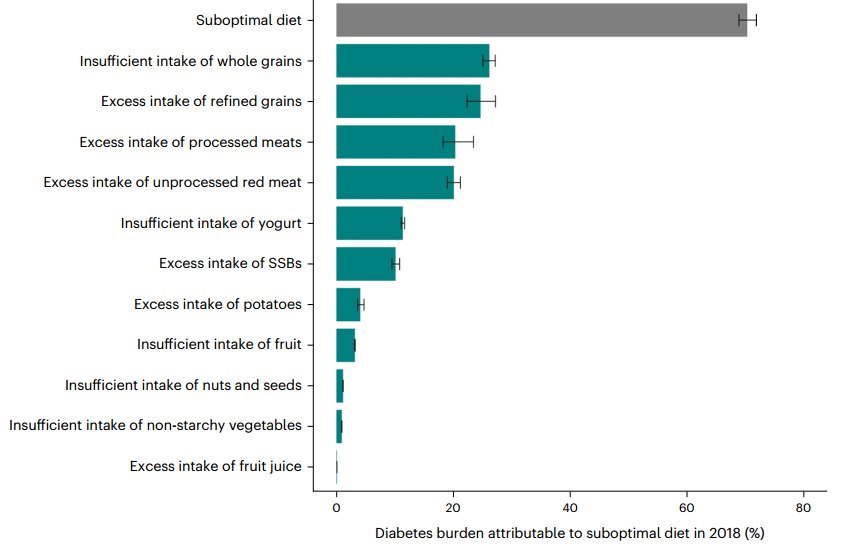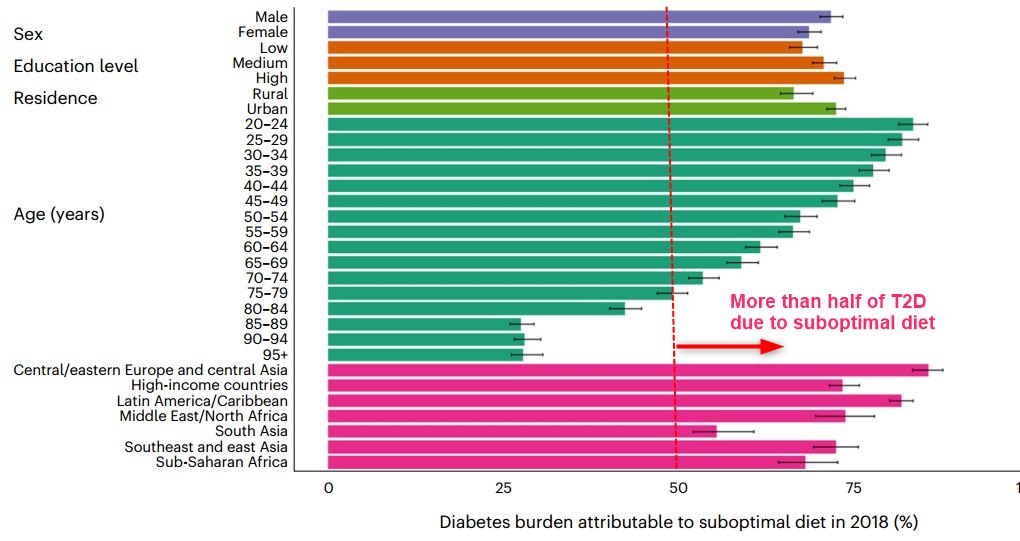Type 2 diabetes attributable to suboptimal diet in 184 countries (note: Vit D, Mg help)
Incident type 2 diabetes attributable to suboptimal diet in 184 countries
Nature Medicine volume 29, pages 982–995 (2023)
Meghan O’Hearn, Laura Lara-Castor, Frederick Cudhea, Victoria Miller, Julia Reedy, Peilin Shi, Jianyi Zhang, John B. Wong, Christina D. Economos, Renata Micha, Dariush Mozaffarian & Global Dietary Database
70% of T2 Diabetes is attributable to suboptimal diet


The global burden of diet-attributable type 2 diabetes (T2D) is not well established. This risk assessment model estimated T2D incidence among adults attributable to direct and body weight-mediated effects of 11 dietary factors in 184 countries in 1990 and 2018. In 2018, suboptimal intake of these dietary factors was estimated to be attributable to 14.1 million (95% uncertainty interval (UI), 13.8–14.4 million) incident T2D cases, representing 70.3% (68.8–71.8%) of new cases globally.
Largest T2D burdens were attributable to:
insufficient whole-grain intake (26.1% (25.0–27.1%)),
excess refined rice and wheat intake (24.6% (22.3–27.2%)) and
excess processed meat intake (20.3% (18.3–23.5%)).
Across regions, highest proportional burdens were in central and eastern Europe and central Asia (85.6% (83.4–87.7%)) and Latin America and the Caribbean (81.8% (80.1–83.4%)); and lowest proportional burdens were in South Asia (55.4% (52.1–60.7%)). Proportions of diet-attributable T2D were generally larger in men than in women and were inversely correlated with age. Diet-attributable T2D was generally larger among urban versus rural residents and higher versus lower educated individuals, except in high-income countries, central and eastern Europe and central Asia, where burdens were larger in rural residents and in lower educated individuals. Compared with 1990, global diet-attributable T2D increased by 2.6 absolute percentage points (8.6 million more cases) in 2018, with variation in these trends by world region and dietary factor. These findings inform nutritional priorities and clinical and public health planning to improve dietary quality and reduce T2D globally.
Estimated T2D cases attributable to suboptimal diet (clipped from PDF)
In 2018, a total of 14.1 million (95% UI: 13.8,14.4 million) estimated new T2D cases, or 70.3% (95% UI: 68.8-71.8%) of the total, were estimated to be due to suboptimal intake of the 11 dietary factors (Supplementary Table 3 and Fig. 1).
Excess intake of six harmful dietary factors jointly
(refined rice and wheat, processed meats, unprocessed red meat, SSBs, potatoes, fruit juice)
contributed a larger proportion of the total global diet-attributable burden (60.8%) than insufficient intake of five protective dietary factors
(whole grains, yogurt, fruits, non-starchy vegetables, nuts and seeds) (39.2%) (Supplementary Table 4) . These proportions were generally similar across world regions in 2018 and globally and across world regions in 1990.
Among individual dietary factors in 2018,
insufficient whole grains (26.1% (25.0-27.1%)),
excess refined rice and wheat (24.6% (22.3-27.2%)),
excess processed meats (20.3% (18.3-23.5%)) and
excess unprocessed red meats (20.1% (19.0-21.2%))
were associated with the highest estimated attributable burden of T2D incidence globally (Fig. 1).
Lowest burdens were attributable to dietary factors having only BMI-mediated effects, such as excess fruit juice (0.09% (0.09-0.1%)), insufficient non-starchy vegetables (0.9% (0.9-1.0%)) and insufficient nuts and seeds (1.1% (1.1-1.2%)).
📄 Download the PDF from VitaminDWiki
VitaminDWiki – Overview Diabetes and vitamin D contains
{include}
Note: 16 Diabetes and Mg studies as of April 2023
Wonder what % of the suboptimal diet is associated with low Magnesium?
See also: Red meat consumption increases risk of Diabetes - many studies
Optimal dietary patterns for prevention of chronic disease - March 2023
Nature Medicine volume 29, pages719–728 (2023) PDF behind a paywall
Peilu Wang, Mingyang Song, A. Heather Eliassen, Molin Wang, Teresa T. Fung, Steven K. Clinton, Eric B. Rimm, Frank B. Hu, Walter C. Willett, Fred K. Tabung & Edward L. Giovannucci
Multiple dietary patterns have been associated with different diseases; however, their comparability to improve overall health has yet to be determined. Here, in 205,852 healthcare professionals from three US cohorts followed for up to 32 years, we prospectively assessed two mechanism-based diets and six diets based on dietary recommendations in relation to major chronic disease, defined as a composite outcome of incident major cardiovascular disease (CVD), type 2 diabetes and cancer.
We demonstrated that adherence to a healthy diet was generally associated with a lower risk of major chronic disease (hazard ratio (HR) comparing the 90th with the 10th percentile of dietary pattern scores = 0.58–0.80). Participants with low insulinemic (HR = 0.58, 95% confidence interval (CI) = 0.57, 0.60), low inflammatory (HR = 0.61, 95% CI = 0.60, 0.63) or diabetes risk-reducing (HR = 0.70, 95% CI = 0.69, 0.72) diet had the largest risk reduction for incident major CVD, type 2 diabetes and cancer as a composite and individually. Similar findings were observed across gender and diverse ethnic groups.
Our results suggest that dietary patterns associated with markers of hyperinsulinemia and inflammation and diabetes development may inform on future dietary guidelines for chronic disease prevention.
